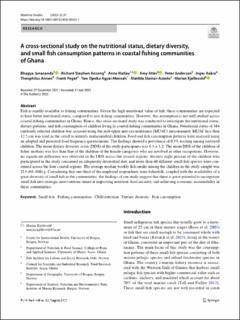| dc.description.abstract | Fish is readily available to fishing communities. Given the high nutritional value of fish, these communities are expected to have better nutritional status, compared to non-fishing communities. However, this assumption is not well studied across coastal fishing communities in Ghana. Hence, this cross-sectional study was conducted to investigate the nutritional status, dietary patterns, and fish consumption of children living in coastal fishing communities in Ghana. Nutritional status of 384 randomly selected children was assessed using the mid-upper arm circumference (MUAC) measurement. MUAC less than 12.5 cm was used as the cutoff to identify malnourished children. Food and fish consumption patterns were assessed using an adopted and pretested food frequency questionnaire. The findings showed a prevalence of 0.5% wasting among surveyed children. The mean dietary diversity score (DDS) of the study participants was 4.3 ± 1.2. The mean DDS of the children of fisher mothers was less than that of the children of the female caregivers who are involved in other occupations. However, no significant difference was observed in the DDS across the coastal regions. Seventy eight percent of the children who participated in the study consumed an adequately diversified diet, and more than 40 different small fish species were consumed across the four coastal regions. The average median weekly fish intake among the children in the study sample was 213 (64–468) g. Considering that one-third of the employed respondents were fisherfolk, coupled with the availability of a great diversity of small fish in the communities, the findings of our study suggest that there is great potential to incorporate small fish into strategic interventions aimed at improving nutrition, food security, and achieving economic sustainability in these communities. | en_US |
